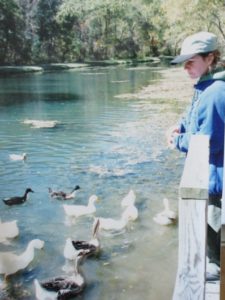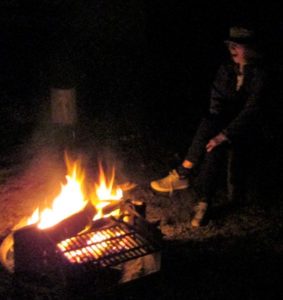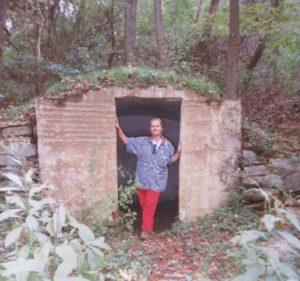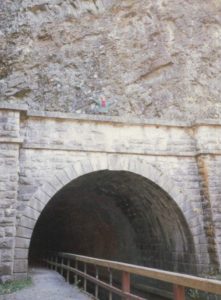 Most of you know this photo from the cover of the SONGBIRD album. It was taken by Eva’s friend Elaine Stonebraker, on one of their bike camping trips. I asked Elaine to tell us the story about those adventures, and she even came up with a bunch of snapshots for illustrations! I hope you enjoy learning more about Eva outside the recording studio.
Most of you know this photo from the cover of the SONGBIRD album. It was taken by Eva’s friend Elaine Stonebraker, on one of their bike camping trips. I asked Elaine to tell us the story about those adventures, and she even came up with a bunch of snapshots for illustrations! I hope you enjoy learning more about Eva outside the recording studio.
Excursions with Eva on the C&O Canal
by Elaine Stonebraker
It was flattering when Eva used to tell me that I was her role model. Of course, she was so, so much more. But we both loved being outside among nature, independent and free, and we both loved challenging ourselves. As her Mom said, Eva and I were best biking buddies.
Eva and I met the first day I worked at Behnke’s. She’d been released from the Tree Crew to come up and help us repot seedlings. As she walked around the corner of the shed and joined us where we all stood beside a huge pile of Growmix, she was warmly greeted by all, but answered simply with a quiet smile. We became friends, and soon our bike trips began.
There was no shortage of adventures awaiting us, as long as we had our “friends”, the bikes. Places like Colonial Beach, VA, were just far enough away to be exotic. The Eastern Shore of Maryland, across the Bay Bridge, has small towns with beautiful old homes. And the pace there was just right for us on our clunky old bikes.
 When we’d cross the causeway at Point Lookout, fishermen would stop and smile at her blonde hair flying out behind her as she rode. Anywhere there was water, Eva wanted to be there, to take in the sparkle on the waves, the changing colors, and the shadows of the clouds moving overhead.
When we’d cross the causeway at Point Lookout, fishermen would stop and smile at her blonde hair flying out behind her as she rode. Anywhere there was water, Eva wanted to be there, to take in the sparkle on the waves, the changing colors, and the shadows of the clouds moving overhead.
Paved trails like the Mount Vernon Trail were fun and interesting, but too crowded for us. We’d chuckle as we admitted that we both found ourselves saying, “All those PEOPLE are in my WAY! ” Still, riding all the way from Mt. Vernon into DC, and cooling our feet in the fountain at the National Gallery of Art, was a delightful way to spend a Monday off.
It seemed that the more we rode, the more essential our explorations became. Escape from the daily routine and our constant money worries was important. A fine day’s outing would be to load up the bikes with rafts, beach towels, and lunches, and abandon the cars to head for the water. Eventually, we began planning annual camping trips on the Chesapeake and Ohio Canal. Riding the entire 184 miles, spaced out over several years, gave us something to look forward to each October. We were as eager to learn as we were to tackle the challenge of all that pedaling. We did have a LOT to learn.
 Thirty years ago, Octobers were cold. It wasn’t just the sleeping on the ground. The cold was biting even as we moved along on our bikes. After the first year (when we had to share one set of gloves between us!), we learned how to plan better. Luckily we never ran out of matches to light a warming fire (photo at left). There were roots to steer around as we pedaled between the Potomac River and the old canal bed, where turtles lined up by the dozens to sun themselves on logs. Sometimes boulders created such rapids in the river that we could hear the water splashing alongside as we rode.
Thirty years ago, Octobers were cold. It wasn’t just the sleeping on the ground. The cold was biting even as we moved along on our bikes. After the first year (when we had to share one set of gloves between us!), we learned how to plan better. Luckily we never ran out of matches to light a warming fire (photo at left). There were roots to steer around as we pedaled between the Potomac River and the old canal bed, where turtles lined up by the dozens to sun themselves on logs. Sometimes boulders created such rapids in the river that we could hear the water splashing alongside as we rode.
Eva was fondly regarded among her friends for her somewhat…eclectic diet. The tuna fish sandwiches didn’t travel well, however, so Cheetos, it was, for her. She laughed at my sunflower seeds and called me a “health food nut”, but by the end of the first trip, we’d both had it with camping food. She decided to take advantage of the proximity of a nearby town, and set off by herself as I tended the campfire. When she returned with cold hamburgers, they could not have been more delicious. And her sense of accomplishment was just as important.
 In the morning, our tents were covered with frost. Our water bottles were filled with solid ice. “Guten morgen, fraulein! ” we’d call to each other in our tents, still snug and warm. But someone had to get up and start the fire. And packing up the bikes again for the next day’s ride often elicited exclamations about the frustration of bungees snapping here and there. But, we somehow figured it out. And off we’d go for the next day’s ride.
In the morning, our tents were covered with frost. Our water bottles were filled with solid ice. “Guten morgen, fraulein! ” we’d call to each other in our tents, still snug and warm. But someone had to get up and start the fire. And packing up the bikes again for the next day’s ride often elicited exclamations about the frustration of bungees snapping here and there. But, we somehow figured it out. And off we’d go for the next day’s ride.
 My memories of those days are some of my most precious. The bright, full moon as we walked up to Licking Creek Aqueduct. Being surrounded by a tunnel of yellow tulip poplars as we left Hancock (the photo at left hardly does it justice). And perhaps my favorite, hearing Eva singing, in Latin, as we pushed our bikes through the Paw Paw Tunnel, “Dona Nobis Pacem.”
My memories of those days are some of my most precious. The bright, full moon as we walked up to Licking Creek Aqueduct. Being surrounded by a tunnel of yellow tulip poplars as we left Hancock (the photo at left hardly does it justice). And perhaps my favorite, hearing Eva singing, in Latin, as we pushed our bikes through the Paw Paw Tunnel, “Dona Nobis Pacem.”
MORE PHOTOS
 This picture was taken at Lockhouse 49 at Four Locks, Maryland, where we got caught in a rainstorm. Our bikes all loaded up with camping gear, there was not much we could do but wait until it was safer to pedal along the towpath. We found this root cellar and I read out out from a paperback I’d brought by Aldous Huxley, “Brave New World”. We were glad to get out of that little space when the rain stopped!
This picture was taken at Lockhouse 49 at Four Locks, Maryland, where we got caught in a rainstorm. Our bikes all loaded up with camping gear, there was not much we could do but wait until it was safer to pedal along the towpath. We found this root cellar and I read out out from a paperback I’d brought by Aldous Huxley, “Brave New World”. We were glad to get out of that little space when the rain stopped!
AT RIGHT: Believe it or not, Eva is standing at the top of the (eastern) portal of the Paw Paw Tunnel! See her up there?
Believe it or not, Eva is standing at the top of the (eastern) portal of the Paw Paw Tunnel! See her up there?
ABOUT THE “SONGBIRD” PHOTO: That one was taken at the North end of Big Pool one morning along the Canal. We’d just left the Hiker-biker campsite at Licking Creek. The night before, there had been the brightest full moon I have ever seen. We’d walked up to the aqueduct and the next morning, were still probably somewhat overwhelmed at the beauty that we’d experienced. So it’s no wonder that such a great photo came of it. I had taken the photo with Eva’s camera, and later Barbara Cassidy sent it along with some others to Blix Street Records. Bill Straw sent me a check for the use of the photo, and another one a few years later. It was like getting a present from Eva.
All photos by Elaine Stonebraker. Used with permission.
ABOUT THE C&O CANAL: The 184.5 mile long Chesapeake & Ohio Canal, built between 1828 and 1850, is today operated as a park by the National Park Service. The towpath, originally built for the use of mules as they towed canal boats, is now a popular recreational trail for walkers, runners, and bicyclists. Along its length are many hiker/biker camping areas such as the ones Eva and Elaine used. In more recent years, some of the original lockhouses have been restored and made available for overnight stays. Here’s a link to another article by Elaine Stonebraker, about her experiences in these historic places. You may have to scroll down, to Canal Story #44.